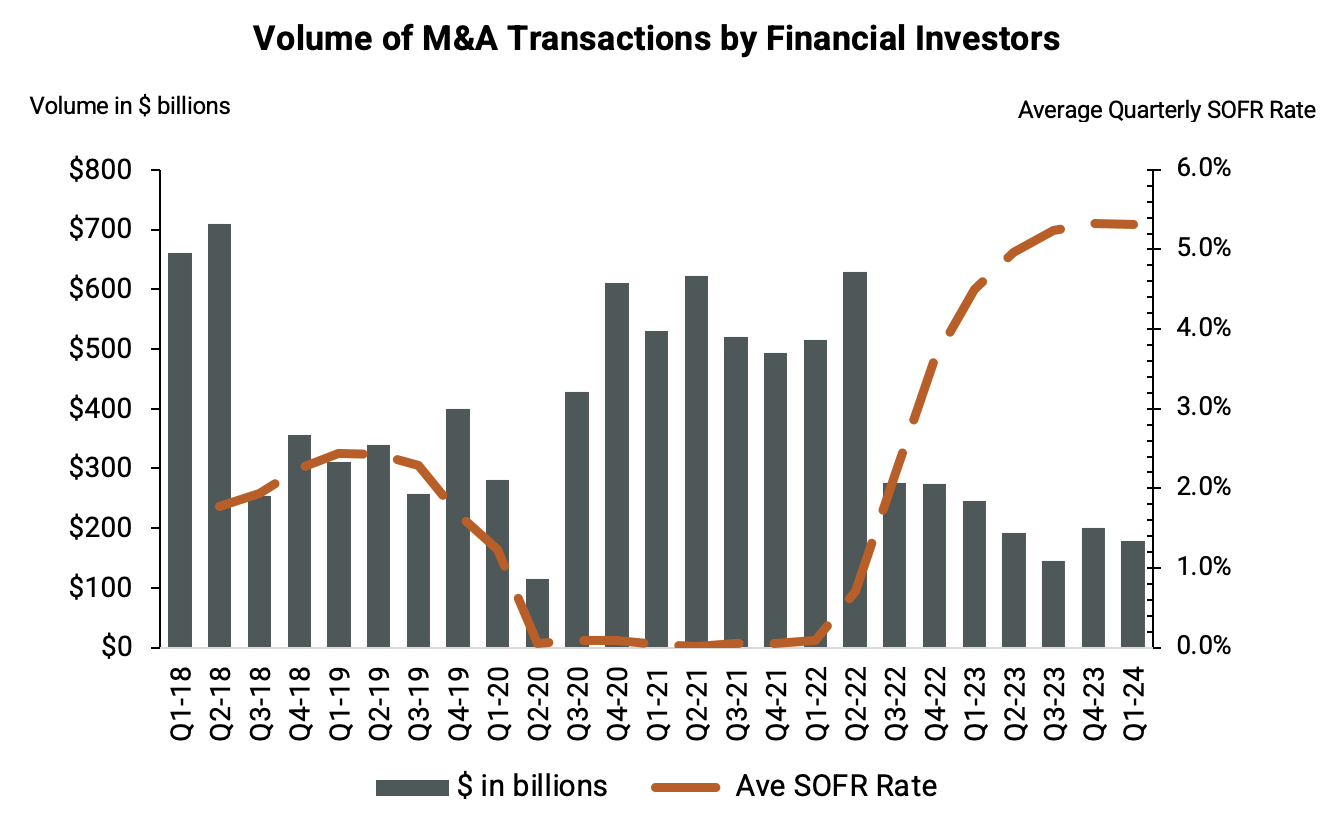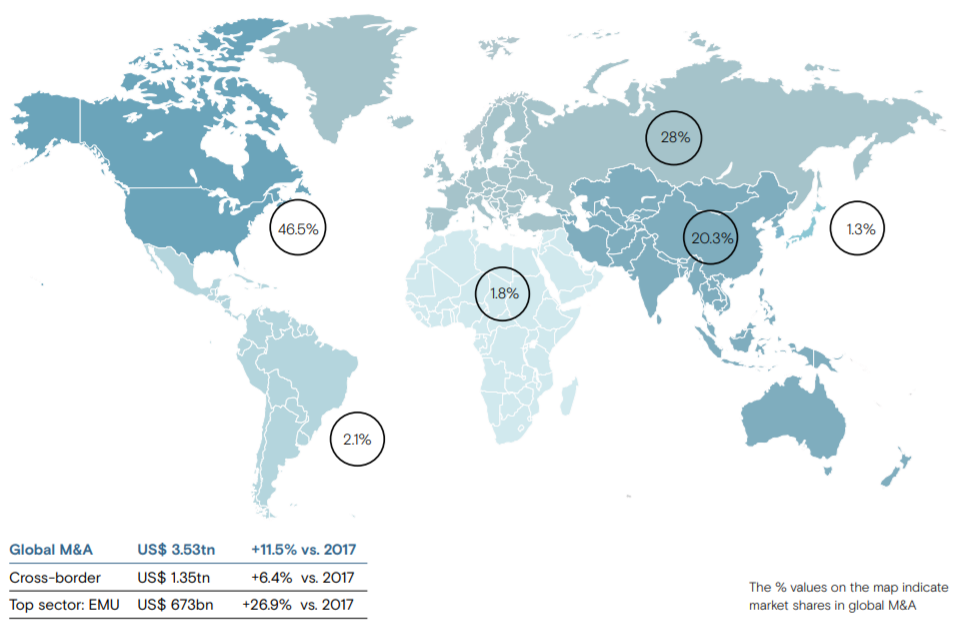Q1’24: Understanding the Link: How Interest Rates Influence Mergers & Acquisitions by Financial Investors
Financial investors like private equity funds and venture capital firms help shape the market dynamics of mergers and acquisitions (M&A) across many industries. But as interest rates have risen precipitously since 2022, there has been a significant decline in the M&A activity among financial investors. What should companies do who are looking for an exit?
Traditionally, financial investors like private equity funds and venture capital firms have played a big role in shaping the market dynamics of mergers and acquisitions (M&A) across many industries. If the acquisitions are funded by debt, however, the acquisition valuation is sensitive to the interest rate environment as current rates drive the cost of capital that is necessary to finance the transaction. This isn’t to say that strategic and corporate acquirers are not impacted by the interest rate environment - they are. But strategic buyers generally have multifaceted rationale for acquiring another company based on its existing or future products, perceived economies of scale, or navigation of their competitive landscape that extends beyond the acquisition’s pure financial return.
As Rates Rise, M&A Activity Drops
Not surprisingly, as interest rates have risen precipitously since 2022, there has been a significant decline in the M&A activity among financial investors. Expectations for declining rates have shifted as the Federal Reserve plans to maintain higher rates longer due to persistently high inflation.
Source: IMMA: Institute for Mergers, Acquisitions, and Alliances, St. Louis FED Economic Data
We can see, with the exception of the market freeze during Covid lockdowns, that when interest rates were extremely low, M&A activity by financial investors increased rapidly and stayed elevated at between $400-$630 billion in quarterly acquisition volume. Since then, deal volume decreased to less than half that amount and was only $180 billion for the first quarter of 2024.
For companies hoping to be acquired in the near future, there is reason to be optimistic. EY-Parthenon predicts a gradual recovery in private-equity backed M&A through the second-half of 2024. Companies that have low-leverage, strong cash flow generation and robust EBITDA growth will be particularly attractive acquisition candidates.
Understanding the macroeconomic environment and making strategic investment and operational decisions today will prepare your company to take advantage of accelerating acquisition activity when interest rates and the cost of capital begins to decrease. The team at Keene Advisors offers deep strategic and financial analysis and planning to optimize your team’s performance and prepare for future inflection points. Contact us today for a complimentary consultation and we can discuss how to tailor solutions to meet your company’s needs.
Disclaimer: This commentary is intended for general informational purposes only. Keene Advisors does not render or offer to render personalized financial, investment, tax, legal or accounting advice through this report. The information provided herein is not directed at any investor or category of investors and is provided solely as general information. No information contained herein should be regarded as a suggestion to engage in or refrain from any investment-related course of action. Keene Advisors does not provide securities related services or recommendations to retail investors. Nothing in this report should be construed as, and may not be used in connection with, an offer to sell, or a solicitation of an offer to buy or hold, an interest in any security or investment product.
KKR’s Strategic Deal with Coty: Case Study
Overview of private equity firm KKR’s investment in global beauty company Coty. A look at private equity deal making amid COVID-19.
The consumer discretionary sector is facing its toughest challenge as businesses remain shuttered due to the coronavirus. In the wake of the COVID-19 pandemic, a growing number of companies have filed for bankruptcy in 2020. Recent high-profile bankruptcy filings include J-Crew, Neiman Marcus, J.C. Penney, and Pier 1 Imports. Without material action or intervention, more companies in this sector can be expected to file for bankruptcy.
With the backdrop of uncertainty stemming from the COVID-19 pandemic, private equity firms stand ready to deploy their capital during this market dislocation. According to data from Preqin, private equity firms are sitting on a record level of dry powder, having amassed a total $1.45 trillion in cash to invest at the end of 2019. Private equity firms have been actively seeking deals in the struggling consumer discretionary sector, which includes travel and leisure, gaming, consumer retail, luxury goods, etc.
One example of such an opportune investment was the recent strategic deal private equity firm KKR entered with the global beauty firm Coty Inc. (the “Company” or “Coty”). On May11, 2020, Coty announced a strategic partnership with KKR. As part of the strategic partnership, KKR initially invested $750 million in Coty through the sale of convertible preferred shares to KKR. Additionally, Coty and KKR signed a Memorandum of Understanding (“MOU”) for the sale of a majority in Coty’s Professional and Retail Hair Businesses, which includes the Wella, Clairol, OPI and ghd brands (together, “SpinCo”) at an enterprise value of $4.3 billion. On June 1, 2020, Coty announced that it has entered into a definitive agreement with KKR for the sale of a majority in SpinCo.
Capture Value with a Winning M&A Pipeline
An effective M&A pipeline is an important component of many companies' growth strategy. Over the past few years of advising companies and private equity firms, we have compiled a list of best practices and useful, customizable resources.
In M&A, much like in other aspects of life, discipline pays. Companies that prepare and thoughtfully execute on acquisition strategies can drive superior value. Companies that remain inactive in the field of mergers and acquisitions potentially miss out on additional value. Simply put, disciplined acquirers outperform.
A strong process is a hallmark of discipline. At Keene Advisors, I often help clients develop and execute on acquisition pipeline strategies. Throughout our assignments with clients spanning billion-dollar companies and middle market private equity firms, we have compiled best practices and resources to streamline the acquisition pipeline process. Read below for helpful guidance and scroll to the bottom to download customizable templates.
Define your universe. Determine the parameters—size, geography, capabilities—that define an attractive acquisition opportunity for your company. Be intentional in your search and keep specific criteria in focus as you assemble your pipeline.
Find your goldmine. In this context, a goldmine is a source of numerous attractive targets. These sources may include relevant expo exhibitor lists, business directories, industry association membership lists, public/private databases, regional business journal publications, etc.
Create a template. Maintain consistency and achieve efficiency by gathering pre-determined fields of information. Pursue a balance where each entry contains just enough information to conduct a quick evaluation of the target while remaining concise enough to allow easy navigation of the database.
Keep a scorecard. Rank targets based on how closely they adhere to the elements you are looking for in a potential acquisition and how actionable the opportunity appears to be. Identifying which companies rank “High” versus “Medium” or “Low” is useful when deciding how to deploy effort and resources in pursuit of a deal.
Match the talent to the task. A smart division of labor ensures everyone is delivering the highest-value work they can produce. Sometimes it means delegating to free up time better spent elsewhere; sometimes it means partnering to get the most efficient execution. Because timing and thoroughness are key in an acquisition process, commit to an agile process.
Luckily, there is no need to reinvent the wheel when it comes to building an acquisition pipeline. Leverage the resources we created to stay a step ahead in your own process. Click below to download an Excel template for a database of potential targets and a PowerPoint template for company profiles.
Mergers and Acquisitions, Capital Markets: 2018 in Review
Major Merger and Acquisition and Capital Markets Trends in 2018
Charts and reports providing a snapshot of the most relevant trends in M&A and capital markets in 2018, including IPO activity, leveraged loan issuance and shareholder activism.
Mergers and Acquisitions, Capital Markets: 2017 in Review
Major Merger and Acquisition and Capital Markets Trends in 2017
Charts and reports providing a snapshot of the most relevant trends in M&A and capital markets in 2017, including new record highs in venture capital investments, private equity fundraising and corporate bond issuance.
Mergers and Acquisitions: 2016 in Review
Major Merger and Acquisition Trends in 2016
Charts, reports, videos and infographics providing a snapshot of the most relevant trends in M&A in 2016, including the rise in divestitures, inbound activity in the US and the importance of the middle-market.








